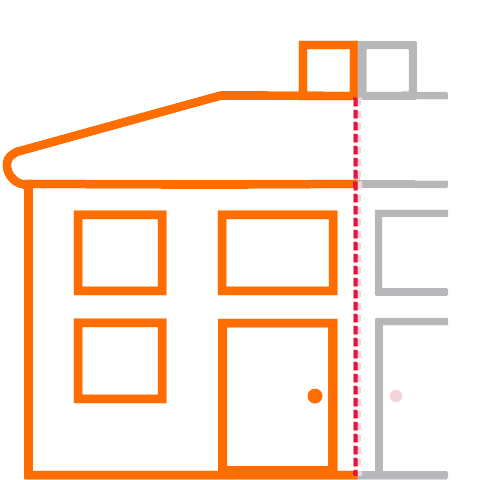The cost to insulate your loft typically ranges from £300 to £1,500, depending on your chosen materials and installation method. Standard 270mm insulation installation averages £700, while topping up existing insulation costs around £500. If you're comfortable with DIY, blanket insulation at £5 per m² offers the most economical option, whereas professional spray foam installation runs £40-£90 per m². Professional labor adds approximately £250 per day, and you'll need to factor in potential extras like electrical wiring relocation at £250. With proper installation potentially saving you up to £600 annually on heating bills, understanding all available options and grants can greatly impact your final investment.
Average Loft Insulation Costs
Table of Contents
ToggleWhen evaluating loft insulation, you'll find costs varying considerably based on the material and installation method you choose. For a standard installation using 270mm thick insulation from scratch, you're looking at approximately £700, while topping up existing insulation to reach the same thickness will cost you around £500.
If you're exploring premium options, spray foam insulation offers superior performance but comes at a higher price point of £40 to £90 per m², and you'll need to factor in professional installation costs. Labor expenses typically run about £250 per day for professional installation services, which you'll want to take into account when budgeting your project.
However, if you're looking to keep costs down, blanket or quilt insulation presents the most economical choice at roughly £5 per m², making it an attractive DIY option. You can expect to pay around £400 for quilt insulation materials, though it's essential to keep in mind that while DIY installation can save you money, it may result in reduced thermal efficiency if not installed correctly.
Consider your comfort level with installation before deciding between professional or DIY approaches.
Types of Loft Insulation
Understanding your insulation options can help you make the best choice for your budget and needs. Each type of loft insulation comes with distinct advantages and cost evaluations that you'll need to weigh carefully.
Blanket or quilt insulation represents the most economical choice at £5 per m², making it particularly attractive for DIY installations.
While mineral wool offers reliable performance at £15 per m², you'll need to wear protective equipment during installation to avoid skin irritation.
If you're seeking a natural alternative, sheep's wool insulation, priced at £23 per m², provides an eco-friendly solution, though it's less effective in confined spaces.
Loose-fill insulation offers a middle-ground option at £7.50 per m², working well for irregular spaces, but you'll want to assess its tendency to shift over time.
For those prioritizing performance and willing to invest more, spray foam insulation delivers superior results at £40-£90 per m². However, you can't install spray foam yourself, as it requires professional expertise and specialized equipment for proper application.
Each option presents a trade-off between cost, effectiveness, and ease of installation that you'll need to evaluate based on your specific circumstances.
Labour and Installation Expenses
The cost of professional labour can greatly impact your total insulation budget, with daily rates averaging £250 for installation work.
If you're dealing with a complex installation site or hard-to-reach areas, you'll need to factor in additional expenses for specialized techniques and extended labour time. When electrical wiring requires relocation, you should expect to add approximately £250 to your installation costs.
While DIY installation presents an opportunity to reduce labour expenses, you'll need to carefully weigh this option against potential drawbacks. Improper installation can compromise your insulation's thermal efficiency and may lead to costly corrections in the future.
This consideration becomes particularly relevant when dealing with spray foam insulation, which costs between £40-£90 per m², as it requires specific expertise for proper application.
You'll find that professional installation, though initially more expensive, often provides better long-term value through proper execution and reliable results.
The investment in skilled labour can help guarantee your insulation performs effectively and meets safety standards, particularly when dealing with complex installations or specialized materials.
Energy Savings and Returns
Investing in proper loft insulation delivers substantial financial returns through reduced energy costs, with homeowners saving up to £600 annually on their heating bills.
You'll notice the most significant impact in detached properties, where installing 270mm thick insulation can result in approximately £590 in yearly savings, particularly if you're upgrading from minimal or aging insulation.
Beyond the immediate financial benefits, you'll find that proper insulation enhances your home's overall comfort while increasing its market value through improved energy efficiency ratings.
The investment you make in loft insulation doesn't just benefit your wallet; it also contributes to environmental conservation.
You're looking at potential reductions of 1,000kg CO₂ equivalent emissions per year, which is comparable to the environmental impact of charging 120,000 smartphones.
To maximize these returns, you'll want to guarantee your insulation meets current building regulations, which will optimize your energy savings over the long term.
The combination of reduced utility bills, increased property value, and environmental benefits makes loft insulation a smart investment that continues to deliver returns year after year.
Key Installation Considerations
Several critical factors demand your attention before starting loft insulation installation.
It's important to address any existing damp issues first, as installing insulation over leaks can exacerbate moisture problems and lead to expensive repairs down the line.
You'll also need to verify proper ventilation remains unobstructed throughout the process to prevent condensation and mold growth, which can compromise both the insulation's effectiveness and your home's air quality.
Before proceeding, you'll want to evaluate your loft's accessibility, as hard-to-reach areas may require professional installation, potentially increasing your project costs.
Don't overlook electrical considerations – you might need to relocate wiring, which could add approximately £250 to your budget.
Additionally, you'll need to determine the appropriate insulation thickness for your specific needs.
While traditional materials might require substantial depth, newer options like spray foam can achieve similar benefits with less thickness.
You should carefully consider the minimum thickness requirements based on your chosen material to make sure you're meeting energy efficiency standards while maximizing your available space.
Environmental Impact and Benefits
When considering the broader impact of loft insulation, you'll find significant environmental advantages that extend far beyond your home's walls. By installing proper loft insulation, you're actively reducing your carbon footprint by up to 1,000 kg of CO₂ equivalent annually, which puts into perspective the substantial environmental benefit when you consider it takes 50 trees to absorb just one tonne of CO₂ per year.
The environmental impact becomes even more compelling when you analyze the energy-saving potential. With 270mm of loft insulation in a detached home, you'll not only save approximately £590 annually but also contribute to a significant reduction in greenhouse gas emissions.
To contextualize this impact, the carbon reduction you'll achieve through proper insulation equals the emissions produced by charging a smartphone 120,000 times. You're effectively minimizing energy waste while promoting sustainable living practices that benefit the broader ecosystem.
As energy efficiency becomes increasingly essential in combating climate change, your decision to invest in quality loft insulation represents a practical step toward environmental stewardship while securing substantial financial benefits for your household.
Grants and Financial Support
The cost of loft insulation needn't strain your budget, thanks to numerous financial support options available in the UK. You'll find several grant schemes designed to help offset the installation expenses, making this energy-efficient improvement more accessible to homeowners across the country.
The Energy Company Obligation (ECO) scheme stands out as a primary funding source, particularly if you're in a low-income household. Through this program, you can receive considerable support for your insulation project, potentially covering a noteworthy portion of the costs.
Additionally, you'll want to explore your local government's offerings, as many councils provide specific grants and subsidies for home insulation improvements. The Green Homes Grant scheme presents another valuable opportunity, where you could receive vouchers covering up to two-thirds of your insulation costs.
Before proceeding with your insulation project, you'll need to verify your eligibility for these financial support options. Requirements can vary greatly based on your location and household income, so it's worth investigating multiple programs to maximize your potential savings.
You'll find that combining different support schemes could markedly reduce your out-of-pocket expenses.





